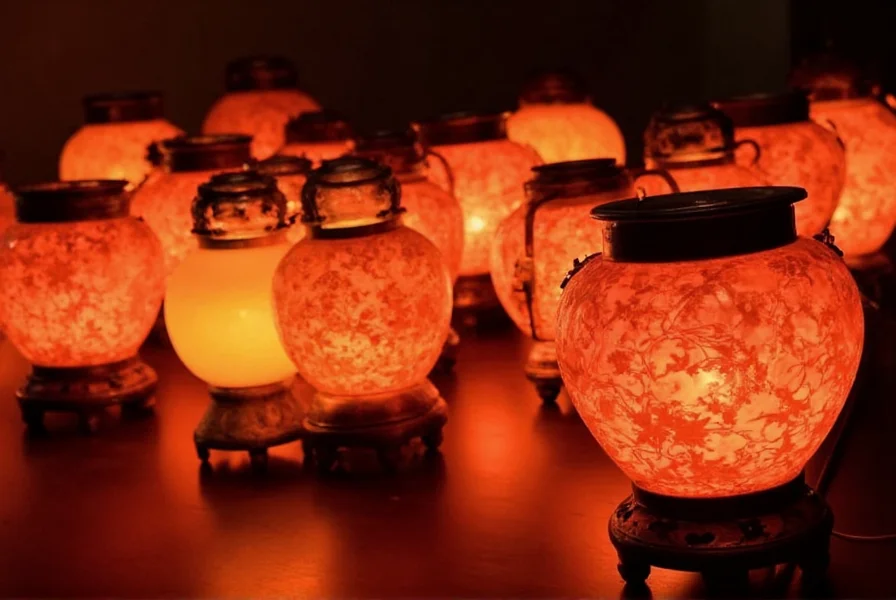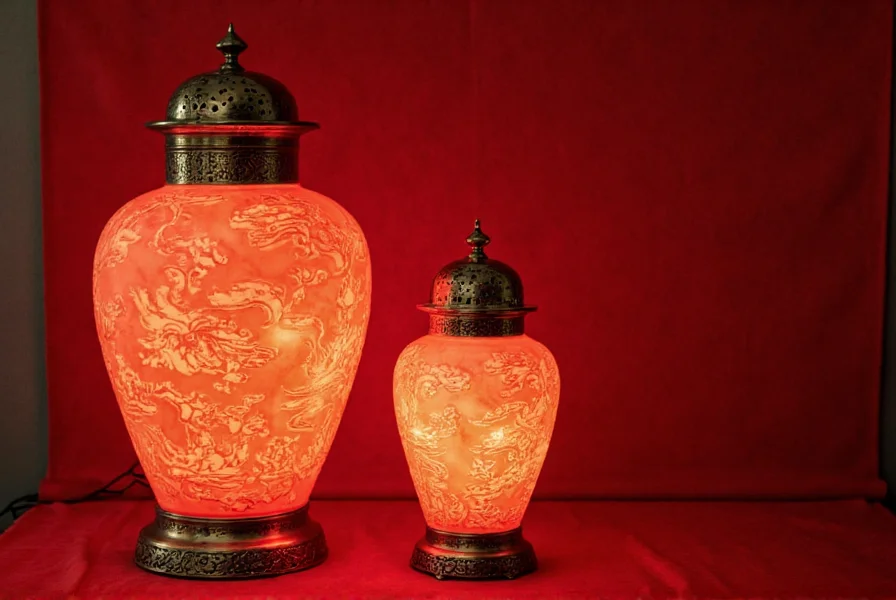The Historical Roots of Ginger Jar Lamps
Ginger jar lamps trace their origins to 17th and 18th century Chinese porcelain containers originally designed for storing spices, oils, and other precious commodities. European traders encountered these beautifully crafted ceramic vessels during the Qing Dynasty and brought them back as luxury items. The distinctive blue and white patterns, often featuring intricate landscapes, floral motifs, and traditional Chinese symbols, made these jars highly desirable decorative objects.
By the 19th century, Western interior designers began repurposing authentic antique ginger jars as lamp bases, recognizing their aesthetic potential. This practice evolved into the modern ginger jar lamp industry, where both genuine antique jars and newly manufactured replicas are converted into functional lighting fixtures. The transformation process involves carefully drilling through the jar's base, installing proper wiring, and mounting appropriate lamp hardware while preserving the jar's artistic integrity.
Design Features of Authentic Ginger Jar Lamps
True ginger jar lamps maintain the distinctive characteristics of their ceramic ancestors. The most prized examples feature hand-painted cobalt blue designs on white porcelain, though modern interpretations come in various color schemes. Traditional patterns include:
- Floral motifs like peonies and chrysanthemums symbolizing prosperity
- Landscapes depicting mountains, rivers, and traditional Chinese architecture
- Symbolic imagery such as dragons, phoenixes, and auspicious characters
- Geometric borders and intricate scrollwork framing the main design
| Type | Height Range | Common Uses | Light Output |
|---|---|---|---|
| Table Ginger Jar Lamps | 12-24 inches | Bedside tables, consoles, desks | Soft ambient lighting |
| Floor Ginger Jar Lamps | 5-7 feet | Living room corners, entryways | Brighter, room-filling illumination |
| Miniature Ginger Jar Lamps | 6-10 inches | Shelves, window sills, accent pieces | Subtle decorative lighting |
How Ginger Jar Lamps Function as Lighting Elements
The ceramic construction of ginger jar lamps creates a unique lighting effect that differs significantly from standard lampshades. The thick porcelain walls diffuse light softly, producing a warm, ambient glow that minimizes harsh shadows. When properly wired, these lamps provide functional illumination while showcasing the intricate artwork visible through the translucent ceramic.
For optimal lighting performance, consider these technical aspects:
- Bulb selection: LED bulbs with warm color temperatures (2700K-3000K) enhance the traditional aesthetic while providing energy efficiency
- Wattage considerations: Most ginger jar lamps work best with 40-60 watt equivalent bulbs to prevent overheating the ceramic
- Shade alternatives: Some designs incorporate fabric or parchment shades to increase light output while maintaining the decorative base
- Dimming capabilities: Installing dimmer switches allows adjustment of light intensity to match different occasions and moods
Incorporating Ginger Jar Lamps into Modern Interiors
Ginger jar lamps offer remarkable versatility across various interior design styles. Their classic appeal bridges traditional and contemporary aesthetics when placed thoughtfully. In traditional settings, they complement other Asian-inspired elements like lacquered furniture and silk textiles. In modern spaces, a single ginger jar lamp creates an intentional focal point against minimalist backgrounds.
Professional interior designers recommend these placement strategies:
- Living rooms: Position floor ginger jar lamps in corners to create warm pools of light that enhance conversation areas
- Dining rooms: Use matching table lamps on a buffet or sideboard to frame the space and provide ambient lighting
- Bedrooms: Select smaller ginger jar table lamps for nightstands to create a soothing atmosphere
- Entryways: Place a floor lamp near the entrance to make a striking first impression with cultural sophistication
When pairing ginger jar lamps with other decor elements, consider creating intentional groupings. Three ginger jars of varying heights on a console table creates visual interest through rhythm and proportion. Alternatively, a single large ginger jar lamp makes a bold statement when surrounded by simpler accessories that don't compete with its intricate design.
Practical Considerations for Ginger Jar Lamp Owners
Selecting the right ginger jar lamp requires attention to both aesthetic and practical factors. Size proportion is critical—oversized lamps can overwhelm small spaces while diminutive pieces get lost in larger rooms. Measure your intended placement area before purchasing, remembering to account for both the jar's diameter and the overall height with harp and shade.
Authentic antique ginger jar lamps require special care:
- Handle with both hands when moving, supporting the base rather than the neck
- Clean with soft, dry cloths; avoid harsh chemicals that might damage hand-painted designs
- Check electrical components annually for safety, especially in older converted pieces
- Position away from direct sunlight to prevent fading of delicate porcelain patterns

Maintaining the Authenticity of Ginger Jar Lighting
The market offers everything from genuine antique ginger jars converted into lamps to mass-produced replicas. Discerning buyers can identify quality pieces by examining several factors. Authentic antique ginger jar lamps typically show subtle variations in painting, minor imperfections from handcrafting, and evidence of age-appropriate materials.
When evaluating potential purchases, look for:
- Hand-painted details with slight inconsistencies (machine-made versions appear too perfect)
- Appropriate patina on metal components consistent with the jar's age
- Quality electrical components properly installed without compromising the jar's structure
- Proportional bases that don't overwhelm the ceramic vessel
Whether you prefer authentic antique ginger jar lamps or high-quality reproductions, these distinctive lighting fixtures continue to captivate interior designers and homeowners with their blend of historical significance and functional beauty. Their enduring appeal lies in the perfect marriage of art and utility—a ceramic vessel originally designed for storage transformed into a source of warm, inviting light.
Frequently Asked Questions
Can ginger jar lamps be used as primary lighting sources?
Ginger jar lamps typically provide ambient rather than primary lighting due to their ceramic construction which diffuses light softly. They work best as supplementary lighting sources in living rooms, bedrooms, and entryways. For task lighting needs, pair them with additional light sources like ceiling fixtures or reading lamps.
How do I determine if a ginger jar lamp is an authentic antique?
Authentic antique ginger jar lamps show hand-painted variations, subtle imperfections from traditional manufacturing, and appropriate aging signs. Check for maker's marks on the bottom, which often indicate Chinese kilns from specific periods. The painting should have slight inconsistencies that machine-made replicas lack, and the ceramic should feel substantial with a natural patina rather than artificial distressing.
What's the best way to clean a ginger jar lamp?
Clean ginger jar lamps using a soft, dry microfiber cloth to avoid scratching the delicate porcelain surface. For stubborn spots, slightly dampen the cloth with distilled water, but never use chemical cleaners which can damage hand-painted designs. Always unplug the lamp and allow it to cool completely before cleaning. Never immerse the ceramic portion in water as this can compromise the electrical components.
Are ginger jar lamps suitable for all interior design styles?
Yes, ginger jar lamps adapt well to various design aesthetics. In traditional spaces, they complement other Asian-inspired elements. In modern interiors, they serve as intentional focal points against minimalist backgrounds. The key is selecting appropriate scale and coordinating with existing color schemes—traditional blue and white works with most palettes, while contemporary color variations can tie into specific room accents.
What safety considerations should I keep in mind with ginger jar lamps?
Ensure proper electrical installation with components rated for the lamp's size and wattage. Ceramic jars can retain heat, so use LED bulbs which run cooler than incandescent options. Verify that any converted antique jars have been professionally wired with adequate ventilation. Place lamps away from flammable materials and never cover them with fabrics or papers that could overheat. Have older lamps inspected by a qualified electrician every few years.











 浙公网安备
33010002000092号
浙公网安备
33010002000092号 浙B2-20120091-4
浙B2-20120091-4